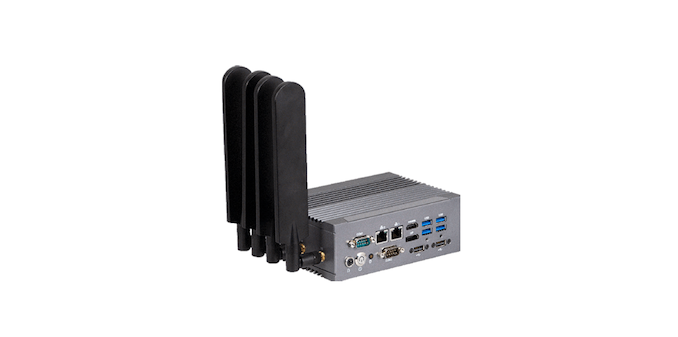5G in a Fanless Industrial PC from GIGABYTE IPC
by Dr. Ian Cutress on July 15, 2020 7:00 AM EST
One of the key verticals in the integration of 5G we are told is in the industrial space – having machines on a shop floor communicate wireless to a central control hub with ultra-low latency or with ultra-high bandwidth. Automation and control are two elements that these designs can bring, which essentially falls under the ‘Internet of Things’ heading.
To that end, GIGABYTE’s Industrial PC division (GIGAIPC) has developed its first 5G certified PC for industrial use cases. As an added bonus, it is a fanless design, equipped with a Core i3-7100U and with space for up to 32 GB of DDR4. The QBiX Pro (QBiX-Pro-KBLB7100HD-A1) has passed verification field tests with Chunghwa Telecom’s 5G network earlier this year, and comes with a number of key industrial features, such as COM header support, dual Ethernet, video outputs, and plenty of USB. GIGAIPC is aiming its new QBiX Pro at automation, transportation, smart retail, medical, edge computing, and essentially anything IoT that requires high-reliability and 5G connectivity in the field.
5G is provided by an on-board PCIe solution, which GIGAIPC hasn’t cited however we have reached out to get this information. It is very likely to be a combination Qualcomm RF and front-end solution for sub 6 GHz, given the Chunghwa verification, which is attached through an onboard M.2 slot. If previous M.2 solutions are anything to go by, these 5G M.2 modules are wider than the standard M.2 widths we see for storage drives.
Update: It is Qualcomm, however we were not told which one.
Related Reading
- UNISOC Unveils T7520 SoC for 5G Smartphones: Octa-Core, 6nm EUV
- Qualcomm’s New 3rd Generation Snapdragon X60 5G Modem, Built on 5nm
- CES 2020: MediaTek Announces New Dimensity 800 Mid-Range 5G SoC
- D-Link Introduces 5G Gateway Solutions
- CES 2020: The Lenovo Yoga 5G with Qualcomm’s 8cx and Support for mmWave/Sub-6
- Quick Bytes: Motorola in Profit, 2020 Focus on Innovation, Foldables, and 5G
- Fireside Interview on 5G with Cristano Amon and Alex Katouzian, Qualcomm










29 Comments
View All Comments
Slash3 - Wednesday, July 15, 2020 - link
How have you not suggested this yet to Linus or Anthony over at Linus Tech Tips as a segment?Flunk - Wednesday, July 15, 2020 - link
Terrifying industrial vulnerablities incoming.PeachNCream - Wednesday, July 15, 2020 - link
On-going rather than incoming.londedoganet - Wednesday, July 15, 2020 - link
Wow, we’ve gotten to the point where a CPU can run at 5GHz in a fanless chassis without melting? /sAlternatively: I thought 5G WiFi was already a thing, so why would putting it in a fanless chassis be something notable? /s
Way too many “5G” terms nowadays.
0ldman79 - Wednesday, July 15, 2020 - link
Indeed.There were three possibilities right off hand.
I'm sure there's something else I'm overlooking.
Dragonstongue - Wednesday, July 15, 2020 - link
G as in communications type not speed as standard CPU "clocks" at.CPU (though you took out of context by using the G in relation to speed not "generation") can easily run multiple Ghz without melting, provided you have clock stop cycles, this allows the chip to "cool down" .. without them halt cycles chips of all sorts would be melting / exploding everywhere, thankfully them Engineer folks who make these things put safety protections into place so it is very unlikely to happen these days
nothing preventing a power virus or what have you from wrecking the chip though, seeing as safe to dead takes all of a few millisecond to release the magic smoke (^.^)
s.yu - Wednesday, July 15, 2020 - link
...and meanwhile Wifi will fulfil the same function with less power not to mention royalties.Danvelopment - Wednesday, July 15, 2020 - link
Isn't that what 802.11AC is for?And presumably latency would be lower because you're not talking through your ISP.
Brane2 - Wednesday, July 15, 2020 - link
Bruce Lee simply responds to market forces.In this case, cops and "Inbtelligence", pepering all areas with this stuff.
USD is crashing, and if you wanna run whole society as an open prison, you need bandwidth...
PeachNCream - Thursday, July 16, 2020 - link
If you're going to be a Russian troll at least try harder to get the language right or post prebuilt, coherent statements that are inflammatory. With low sophistication efforts like this one, I'm surprised you people would even waste the time.